One of the most impressive places I’ve seen during my recent visit to Barcelona was the Colonia Güell.
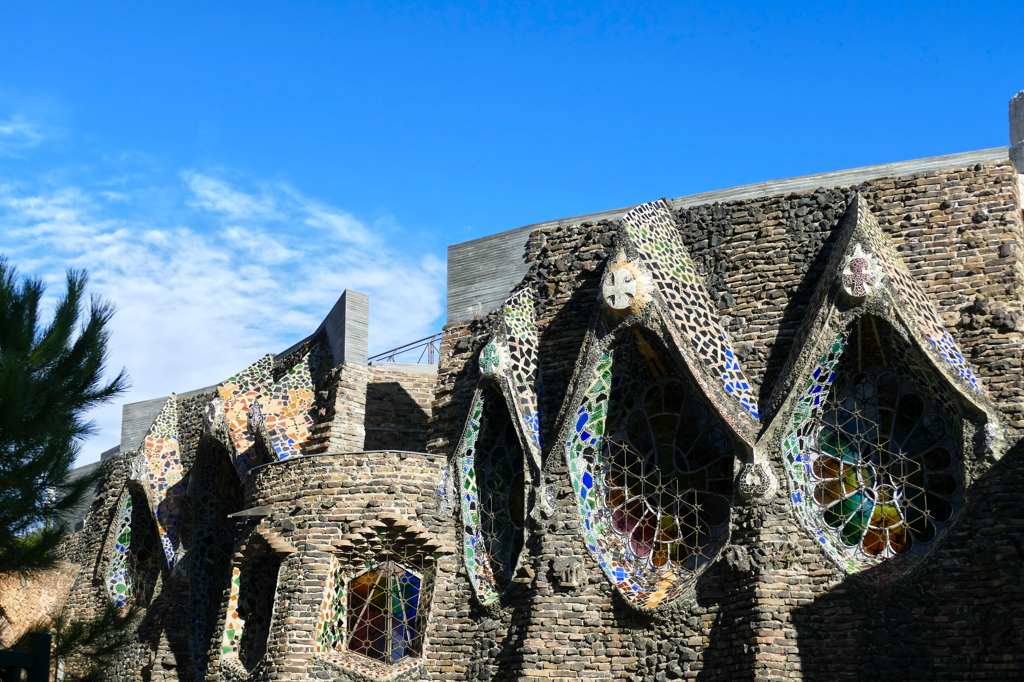
The Colonia Güell is a former industrial settlement including a factory and residential buildings for the workers as well as a famous crypt by Antoni Gaudí. It is named after its proprietor, the magnate Eusebi Güell, obviously. The Colonia is part of the village of Santa Coloma de Cervelló about 23 kilometers west of Barcelona.
- Colonia Güell
- Eusebi Güell i Bacigalupi
- Self-Guided Tour of the Colonia Güell
- Antigua Cooperativa de Consumo, the Former Cooperative
- Antiguas Bodegas, the Old Warehouses
- Casa del Secretario, the Secretary’s House
- Convento de las Monjas, the Nunnery
- Centre Cultural Sant Lluís, the Cultural Center
- Ateneo Unío and Teatro Fontova, the Lounge and the Theater
- Escuela y Casa del Maestro, the School House and the Teacher’s Home
- Ca L’Espinal, the Factory Manager’s Home
- Casa del Metge, the Doctor’s Home and Clinic
- Ca L’Ordal, the Farmers’ Houses
- Can Soler de la Torre y Capilla de la Mare de Déu dels Dolor, Güell’s Residence and Chapel
- Recinto Industrial, the Industrial Plant
- Depósito de Agua, the Water Reservoir
- Gaudi’s Crypt
- Casa Parroquial, the Parish House
- Can Julia de la Muntanya, the Farmhouse
- Castillo Torre Salvana, the Castle Tower
- How to Get to Santa Coloma de Cervelló
- How to Visit the Colonia Güell
- Where to Eat
- Map
- Pinnable Pictures
Colonia Güell
Eusebi Güell i Bacigalupi founded the Colonia Güell on his Can Soler de la Torre estate in Santa Coloma de Cervelló in 1890. However, the idea to unite working and living spaces in one spot wasn’t really new. Actually, Salvador Pagès Inglada commissioned Antoni Gaudí with a manufacturing and residential complex in Mataró years before. But in contrast to the Colonia Güell, his Cooperative Obrera Mataronense could never be realized.
Say It Right
Since especially English speakers tend to butcher Güell’s name, here’s the ultimate hint on how it’s pronounced. Actually, it’s very simple as you just need to put a G in front of the word well: Gwell.
That’s it – easy, right?
At the Colonia Güell, workers and their families were provided with affordable housing in the factory’s vicinity. The families had access to medical care and their children could visit a school. Also, a cooperative offered supplies at relatively cheap prices. There were even cultural facilities.
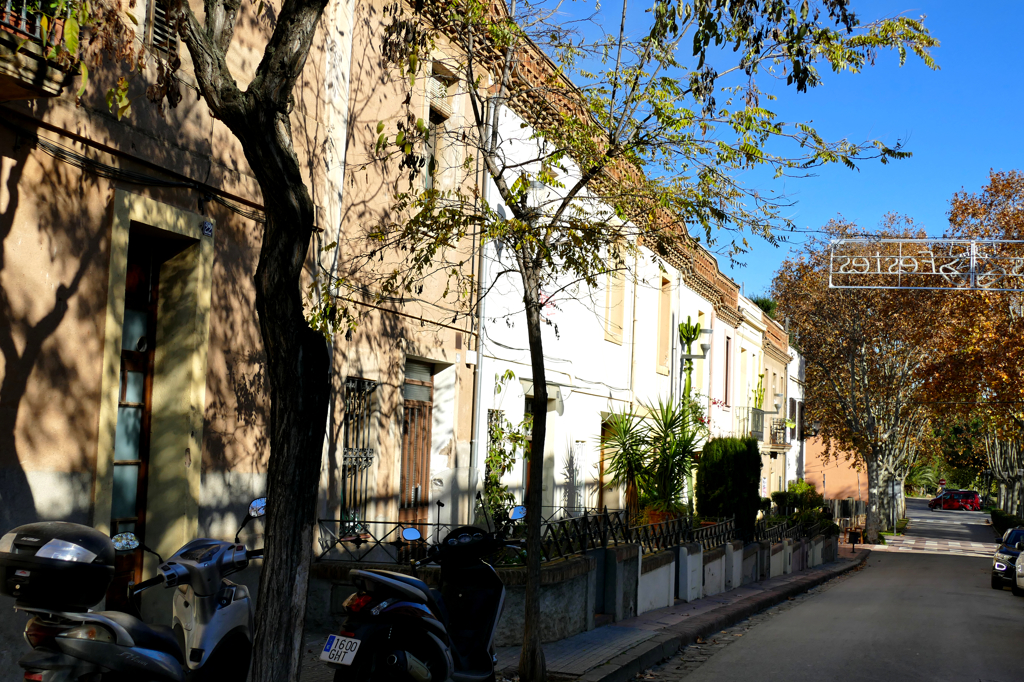
While Güell followed a relatively social and advanced concept, he had moved his textile factory away from Barcelona’s social conflicts. Also, by housing the workers right on his property next to the plant…well, I wouldn’t go so far as to use the term serfage, but let’s be real, the concept is very similar. Obviously, those people lived in a Güell-bubble, no matter how pretty it glistened.
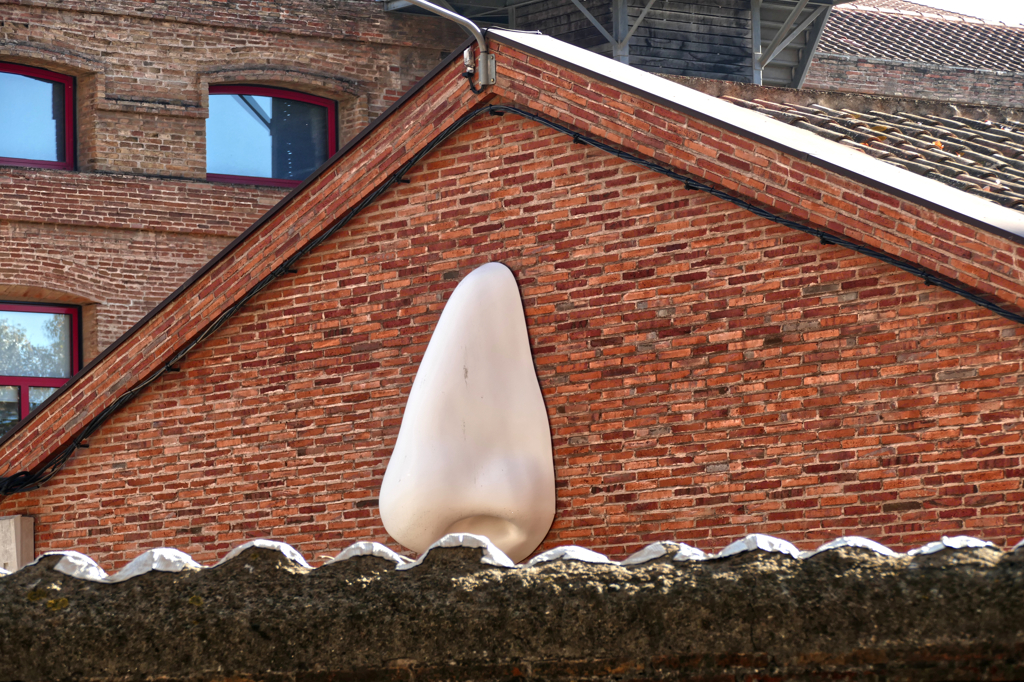
However, unlike the majority of industrialists, Eusebi Güell indisputably granted his workers social improvements. He also used his status as a patron of culture and equipped the Colonia Güell with cultural and religious facilities built in Modernist fashion.
Tables Turn
Nevertheless, over the years, even sleepy little Santa Coloma de Cervelló had to face social insurrections and workers who joined trade unions.
At the beginning of the civil war, the plant was collectivized and run by its workers. At the end of the war, however, it was returned to the Güell family who sold it to the Bertrand y Serra family in 1945. Due to an economic crisis, it was closed in 1973.
On Beauty
What makes the Colonia a fantastic landmark to this date, however, is the architecture. Some of the most famous Modernist architects contributed to this outstanding project. The most famous building of the Colònia Güell is indisputably the Gaudí crypt. Güell commissioned Gaudí to build a church in 1898. However, the construction began only ten years later.
Nevertheless, just like the Sagrada Família, the ambitious plan was never fulfilled. The Güell-family declared in 1914 they no longer would finance the project. Therefore, Gaudí never finished his project. Due to these financial issues, he only completed the lower nave, called the crypt, as well as the portico.
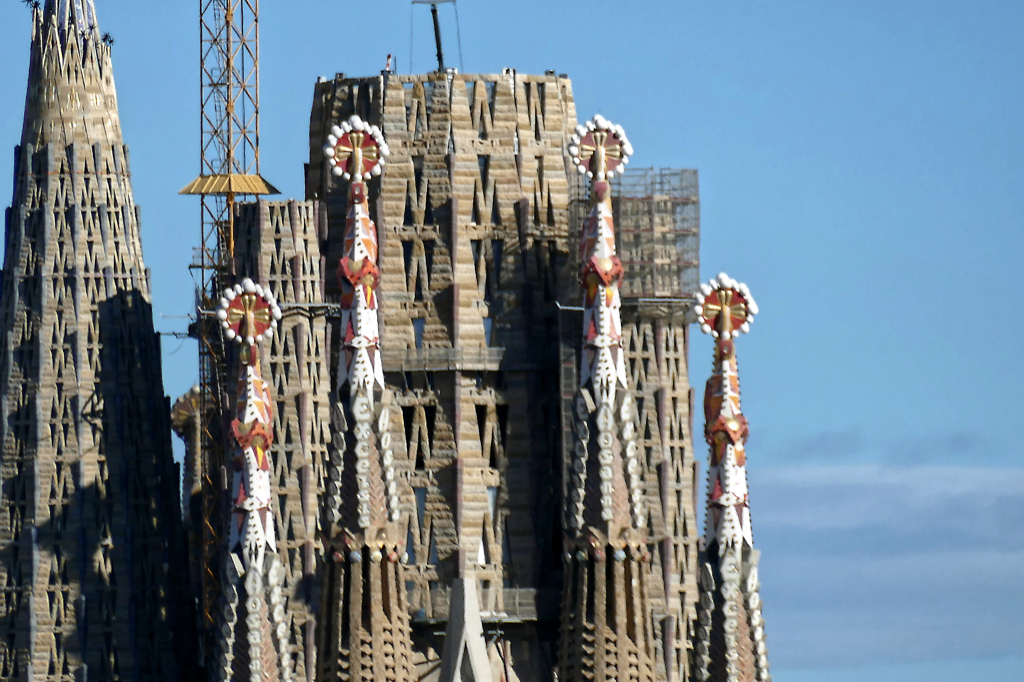
After years of neglect, only recently, the Colonia Güell has been preserved’n’promoted. Some of the buildings are rented out to companies.
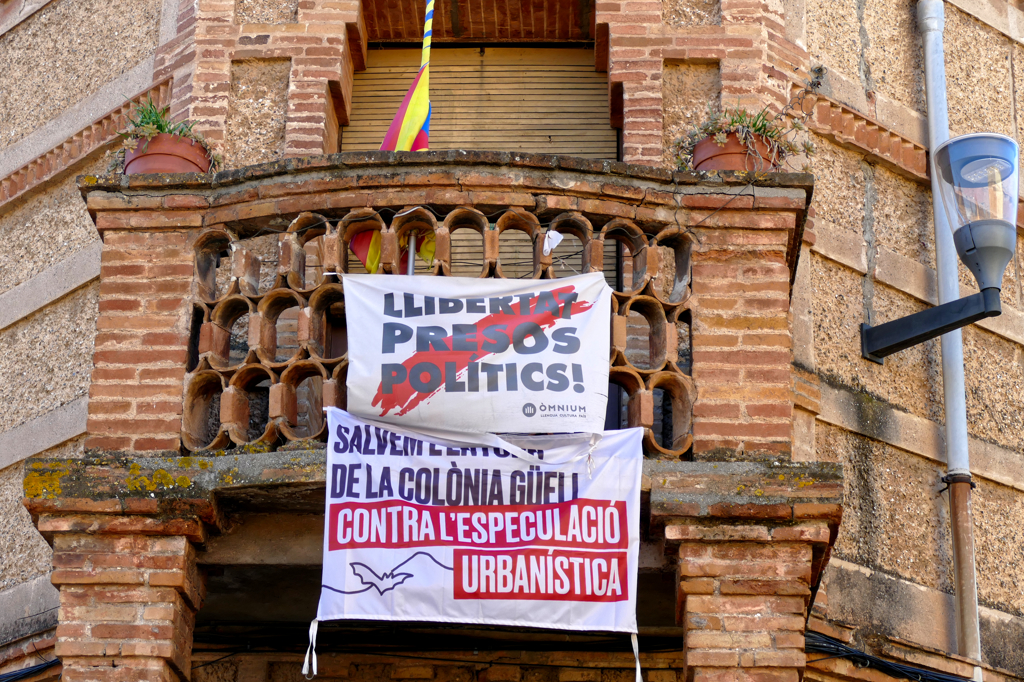
Currently, some 800 people reside on the site, and arguably, not everyone is happy with the attention and upscaling of the neighborhood. Obviously, residents fear the downside of gentrification.
Eusebi Güell i Bacigalupi
Count Eusebi Güell i Bacigalupi was a Catalan entrepreneur, patron, and politician.
Born in 1846 in Barcelona, Eusebi Güell, whose name is pronounced goo-el, is best known for his close ties to the work of Antoni Gaudí. To this date, many of Gaudi’s creations are bearing their patron’s name. Consequently, you’ll find many projects by the name of Güell. Some of those made it to the list of UNESCO World Heritage Sites.
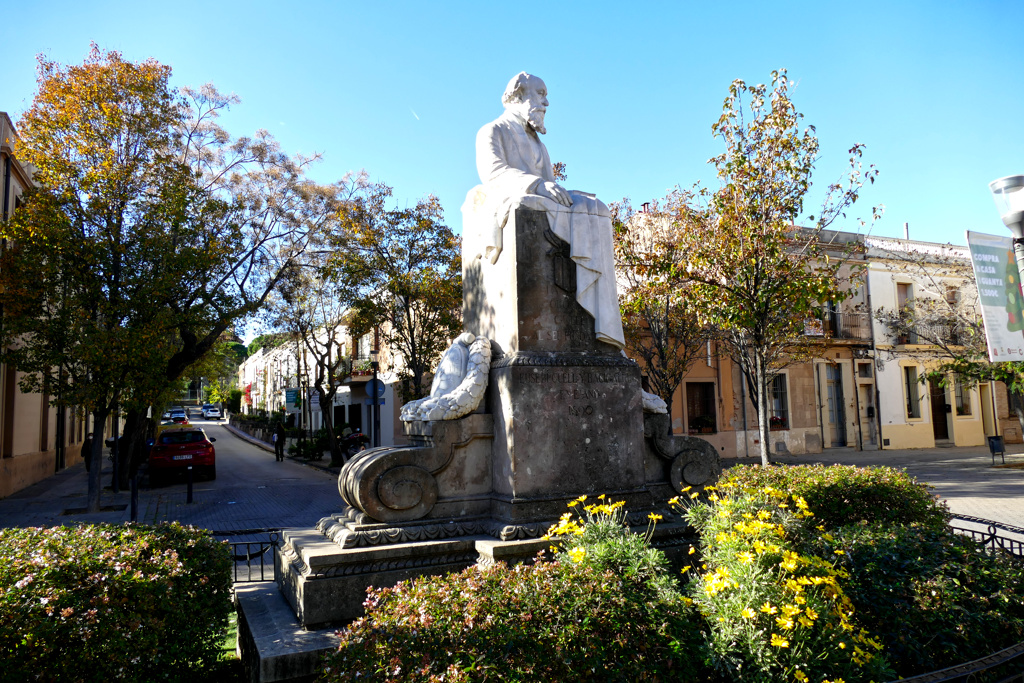
Güell married Luisa Isabel Lopez y Bru, daughter of the first Marquis of Comillas, in 1871. The couple had ten children.
Who Wants to Be a Billionaire?
Güell’s father was a successful businessman who first made his fortune in Cuba – like many Catalans in that era. Eusebi Güell successfully continued business in his hometown after having studied law and economics in Barcelona, England, and France. His main profit came from the industrialization in the region at the end of the 19th century. Especially the fabric industry grew significantly. But Güell was also successful in real estate. In the growing city of Barcelona, the value of his estates grew rapidly. Converted to today’s estimates, his funds would be around € 70 billion. This makes him one of the richest people ever.
Yet, Eusebi Güell also promoted both art and charity projects. Also, he granted the employees at his companies comparatively good working conditions and even social benefits.
In 1875, Güell became a member of the Barcelona City Council and eventually a member of the Provincial Assembly of Catalonia. For his services, King Alfonso XIII ennobled him in 1908.
Self-Guided Tour of the Colonia Güell
There are different ways to visit the Colonia Güell. You can join a guided tour, however, exploring Santa Coloma de Cervelló self-guided is a great alternative. As you pick up one of the audio guides that come in nine languages, they supply you with an informative map, and you can easily explore the center at your own pace.
Antigua Cooperativa de Consumo, the Former Cooperative
Since the former cooperative building houses the information point today, you basically have to start your tour here.
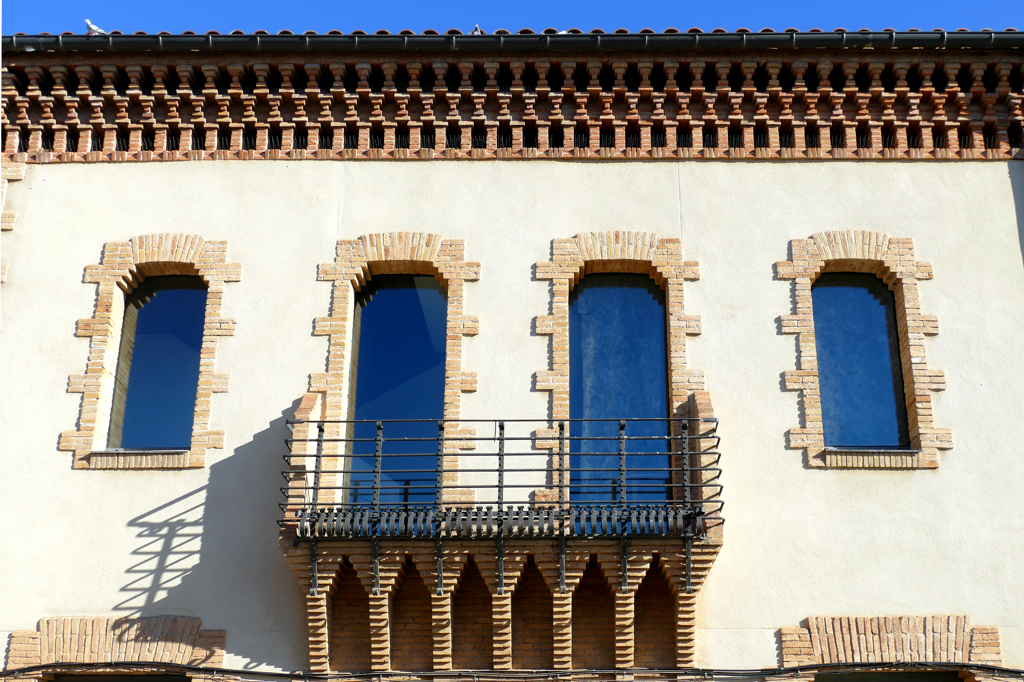
Built in 1900 by architects Francesc Berenguer i Mestres and Joan Rubio i Beliver, there is an exhibition on the history of fabric production, the town of Santa Coloma de Cervelló, as well as Güell’s housing and manufacturing project on the upper floors.
Antiguas Bodegas, the Old Warehouses
Right across from the old cooperative on Carrer Reixach, you will find an elongated building. These were the old warehouses built in 1920.

Since this group of houses with a long porch on the upper floor has lots of industrial charm, it’s a sought-after space for offices, agencies, and events.
Casa del Secretario, the Secretary’s House
The so-called secretary’s house used to be the home of the secretary of the city council. Interestingly, its architect is unknown. Today, it houses a clinic.
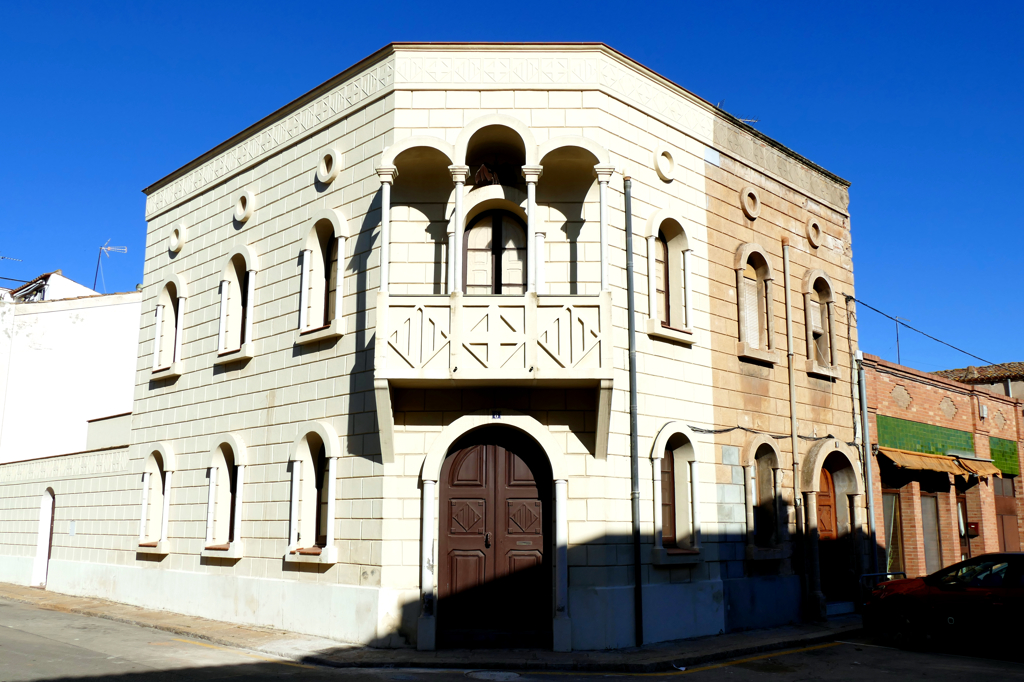
This house is very different from the other buildings of the Colonia. It is entirely made of plastered brick with windows built in the shape of a semicircular arch and buttressed by columns.
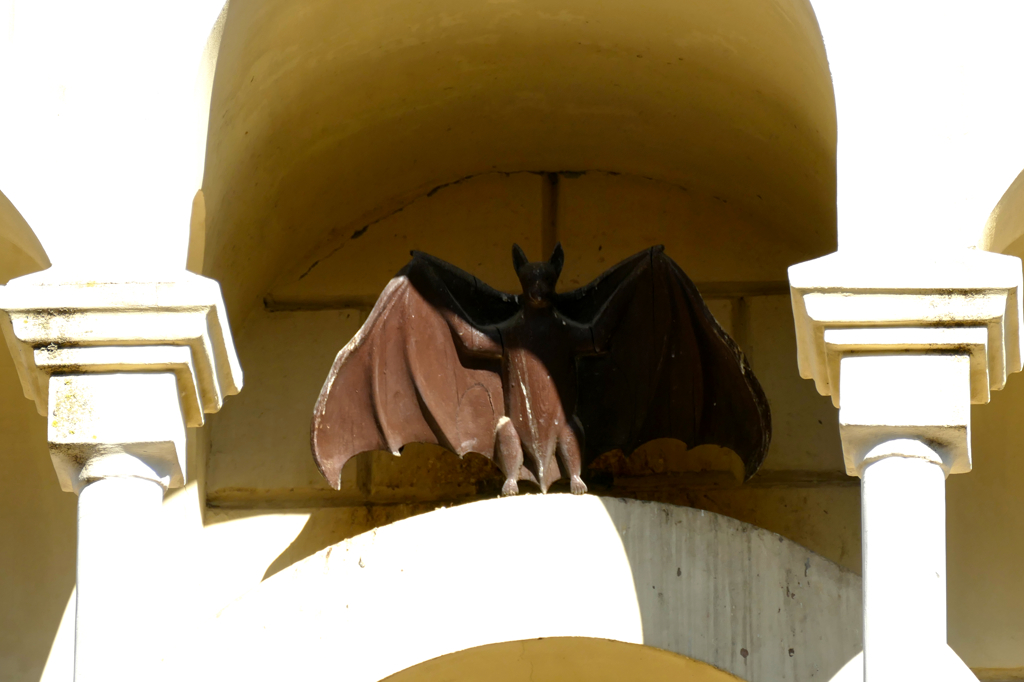
The small bat, as well as four Catalan bars on the balcony, are proof of the Güell family’s strong Catalan identity. You’ve got to know that a bat sits on top of the coats of arms of Barcelona, Valencia, and Palma de Mallorca. Therefore, it is a symbol of Catalan identity.
Convento de las Monjas, the Nunnery
Also, the architect of the old convent of the nuns remains unknown. All that’s known is that it dates back to 1891 respectively 1892. Today, it houses the town’s civic center.
Centre Cultural Sant Lluís, the Cultural Center
The Sant Lluís cultural center hosted various activities for the children of the Colonia. From 1932, part of the building housed a library. The family of the poet Joaquim Folguera i Poal, a son of the Colonia, donated their personal book collection.
The library had to be closed until 1975 due to acts of revenge in the aftermath of the closure of the factory in 1973. After its reopening, it became part of the libraries of Barcelona.
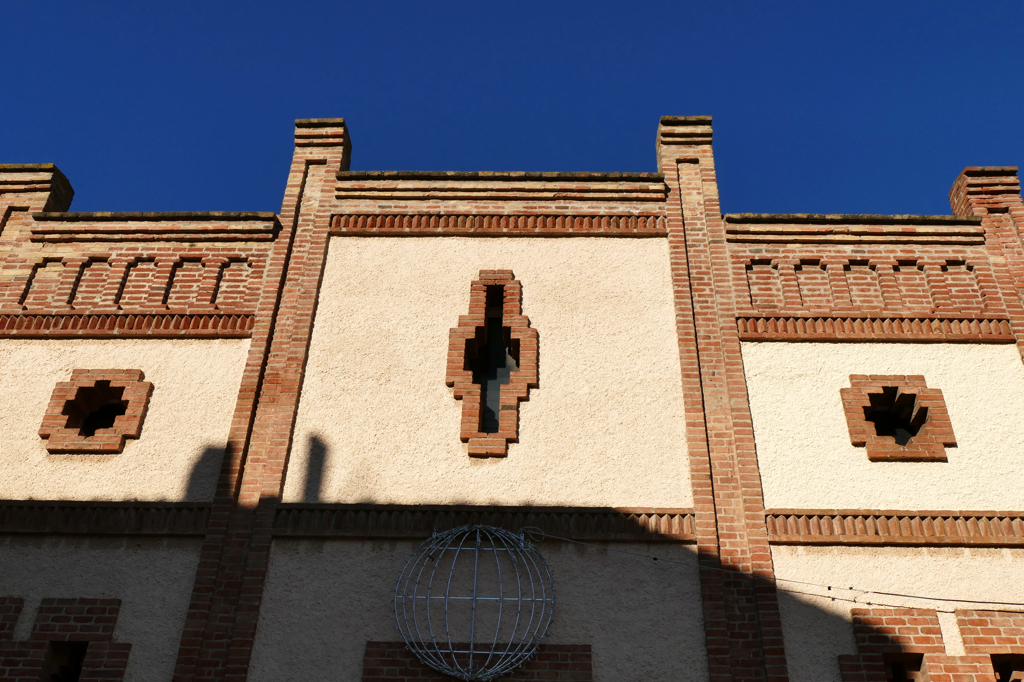
Francesc Berenguer i Mestres built the Centre Cultural Sant Lluís between 1915 and 1918.
Brick pilasters are deciding the main façade into three parts. Through the wrought iron door to the right of the building, you can enter a small courtyard.
To this date, the Centre Cultural Sant Lluís is Santa Coloma de Cervelló’s cultural center.
Ateneo Unío and Teatro Fontova, the Lounge and the Theater
Interestingly, the factory workers themselves carried out the construction of this communal building between 1892 and 1899.
It is a complex of two buildings.
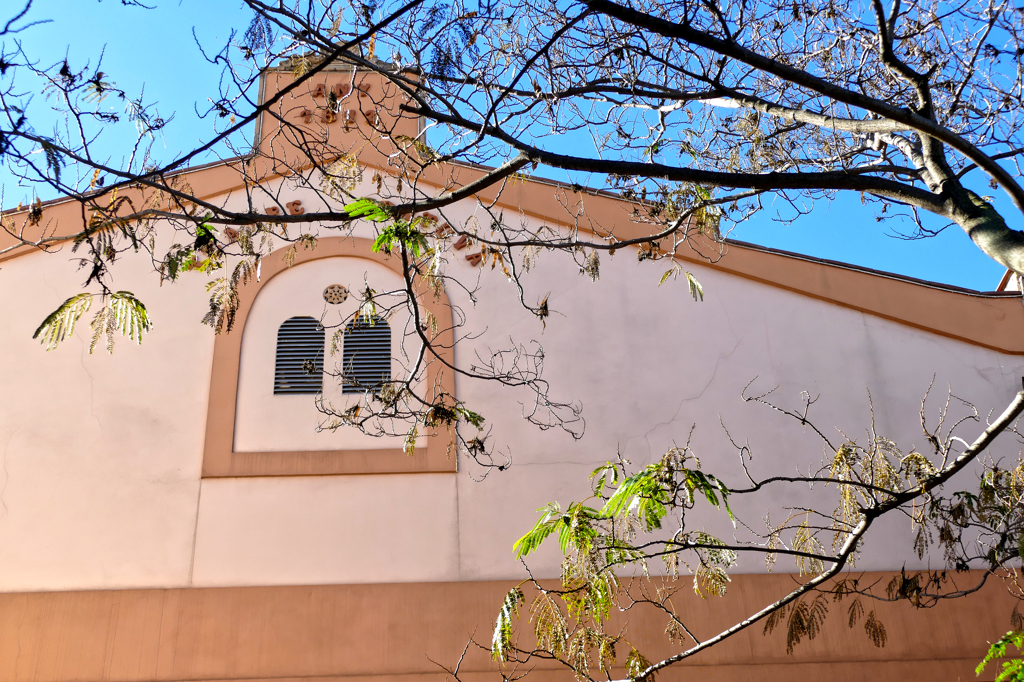
As I pointed out above, Güell followed the principle of bread and circuses. Hence, recreational features and a social atmosphere were important assets of life at the Colonia. At the beginning of the century, reading and chatting at coffee houses as well as attending theater plays were the most popular leisure activities. Therefore, this complex was one of the first communal additions to the Colonia Güell.
The café is still operating and is one of the largest and most popular restaurants in Santa Coloma de Cervelló.
Escuela y Casa del Maestro, the School House and the Teacher’s Home
The northernmost building at the end of Carrer Barrau is the school with the adjacent teacher’s home. It stands on a small elevation on the outskirts where the town merges into the quaint countryside.
Francesc Berenguer i Mestre and Francesc Berenguer i Bellvehi built the school complex in 1910 and 1911.
Unlike most of the other buildings at the Colonia, it is built from large stone slabs instead of brick. I find this feature makes it look like a Medieval castle. A large number of windows allows for optimal lighting in the classrooms.

The teacher’s house with its prominent circular tower stands right next to the school building. Although the school and the residence are two separate buildings, they are connected by a bridge on top of two arches.
The school, like the other services of the colony, was generally free for the children of the workers. The teaching of the boys differed from that of girls. Nuns were in charge of the education of the girls. They focused on manual and domestic work.
Today, the building still houses the town’s school.
Ca L’Espinal, the Factory Manager’s Home
Joan Rubió y Bellver built the Ca l’Espinal as the residence of Mr. Espinal in 1900. Espinal was the factory manager and company director.

What most attracts the attention of Ca l´Espinal is undoubtedly the southern corner in the shape of a Medieval turret. However, the set of borders on the façade and most of all the artful brick latticework are absolutely exquisite.
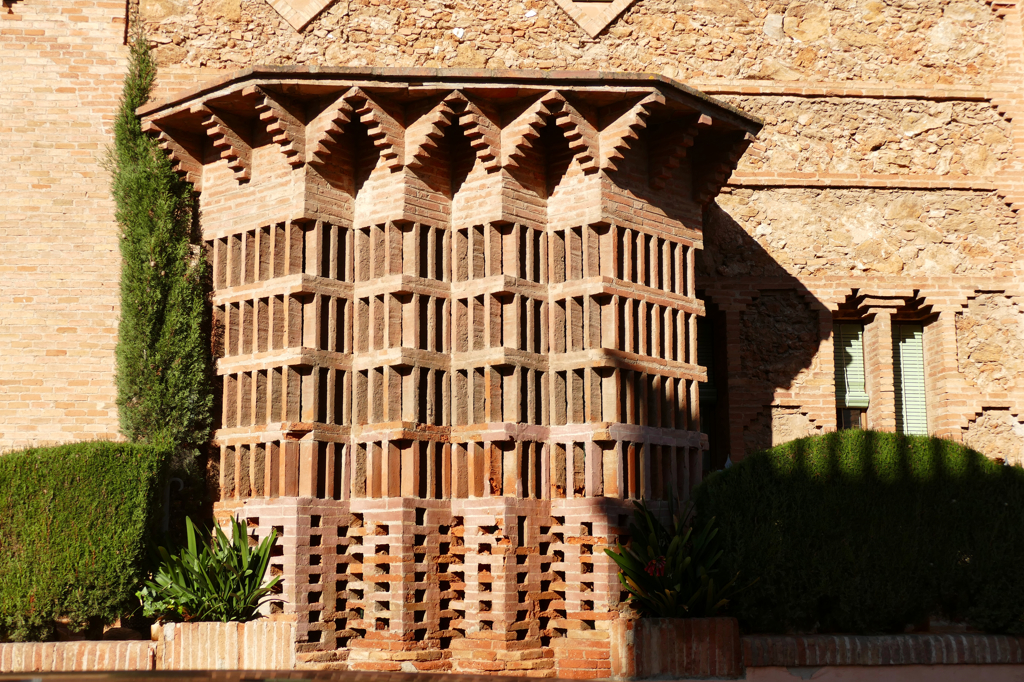
The architect achieved a geometric rhythm by combining the horizontal lines of the dividing strips of the facades with the rhomboid shapes of the windows and borders.
Without any doubt, the Ca l´Espinal is one of the Colony’s gems.
Casa del Metge, the Doctor’s Home and Clinic
The doctor lived at the Casa del Metge, but he also used it as his consulting room.
It is a detached building surrounded by a small garden. Geometric brick patterns are embellishing the square two-storey building’s façade. Particularly striking is the zigzag frieze that hides the vents and the jagged eaves of the roof.
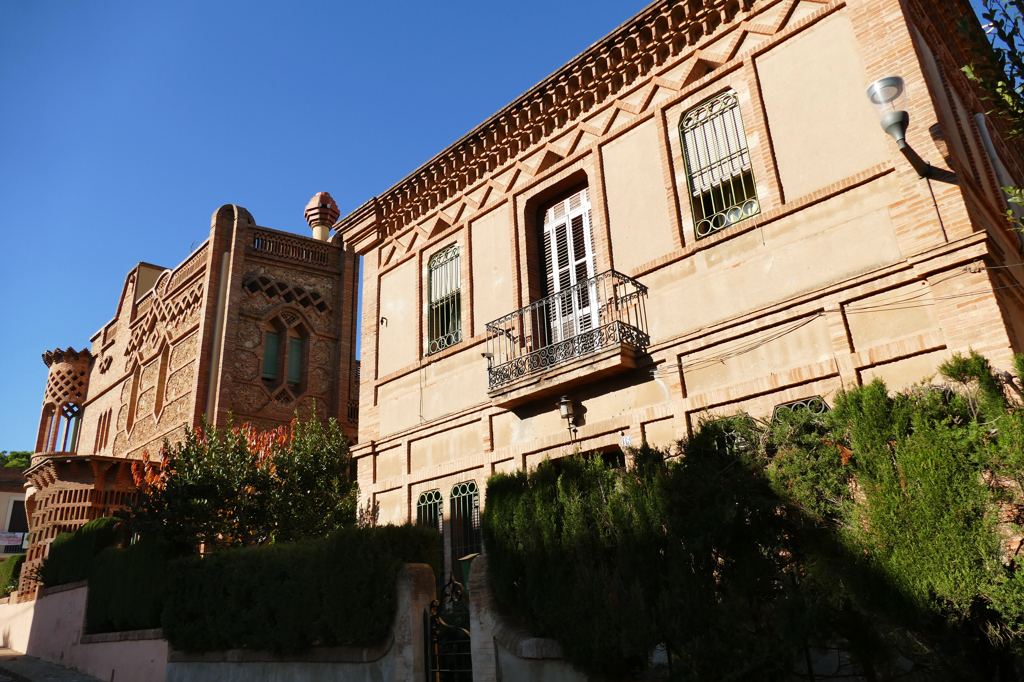
The Casa del Metge was built in 1910, however, the architect is unknown.
Ca L’Ordal, the Farmers’ Houses
In 1894, Joan Rubió i Bellver designed this Modernist building that presides over Plaça Anselm Clavé. Therefore, Ca l’Ordal is the most centrally located building on the circuit of the Colonia Güell.

As a matter of fact, it consists of three small single-family houses. On the street level, each façade is decorated with a different brick pattern. But filigree of the brickwork also adorns the rounded corners, the windows, and the three chimneys.
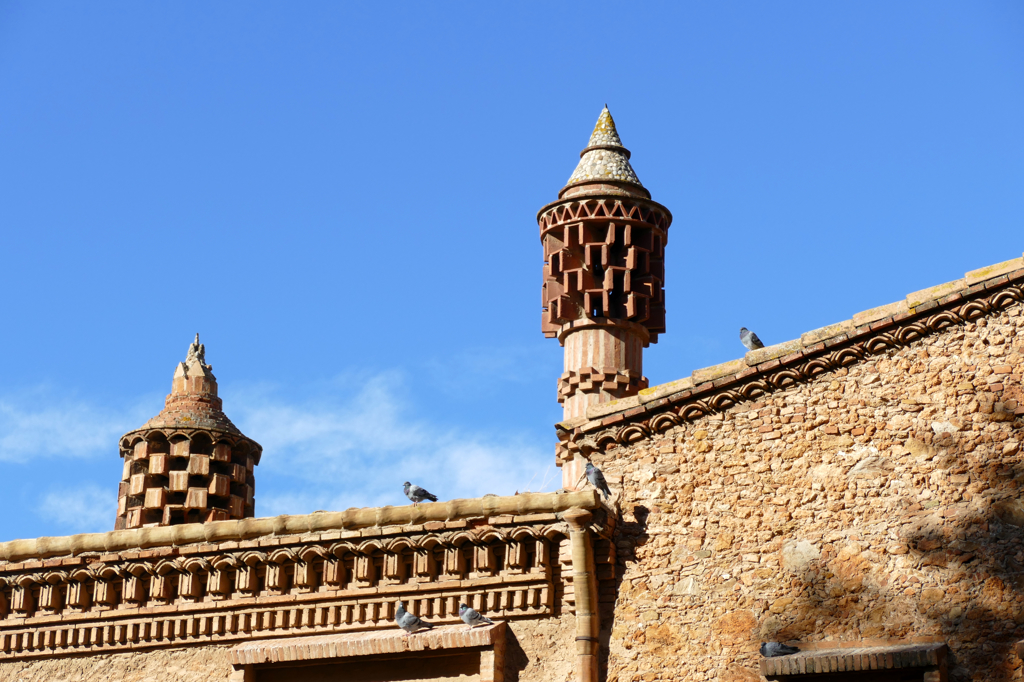
It was the home of the Ordal, Curañas, and Gaudó families. They were peasants who worked on Güell’s land or in his factory.
Today, the Ca l’Ordal is a private residence.
Can Soler de la Torre y Capilla de la Mare de Déu dels Dolor, Güell’s Residence and Chapel
The country house Can Soler de la Torre had originally been the property of Antoni Soler de la Torre. He had been one of the leading figures during the Revolt of the Barretines, a peasant revolt against the abusive troops of King Charles II in 1688. Betrayed by a house boy, he was then murdered and his head was hung in a corner of Barcelona’s town hall. His mansion was demolished and the land was destroyed.
In 1692, the farmhouse was rebuilt and given its current appearance. Therefore, on the façade, you’ll spot two dates referring to the house’s origin. 1622 is the year it was originally built, and 1692 is when it was rebuilt after being basically erased.
In 1860, the Soler family sold the house and the estate to Joan Güell y Ferrer, Eusebi’s father.
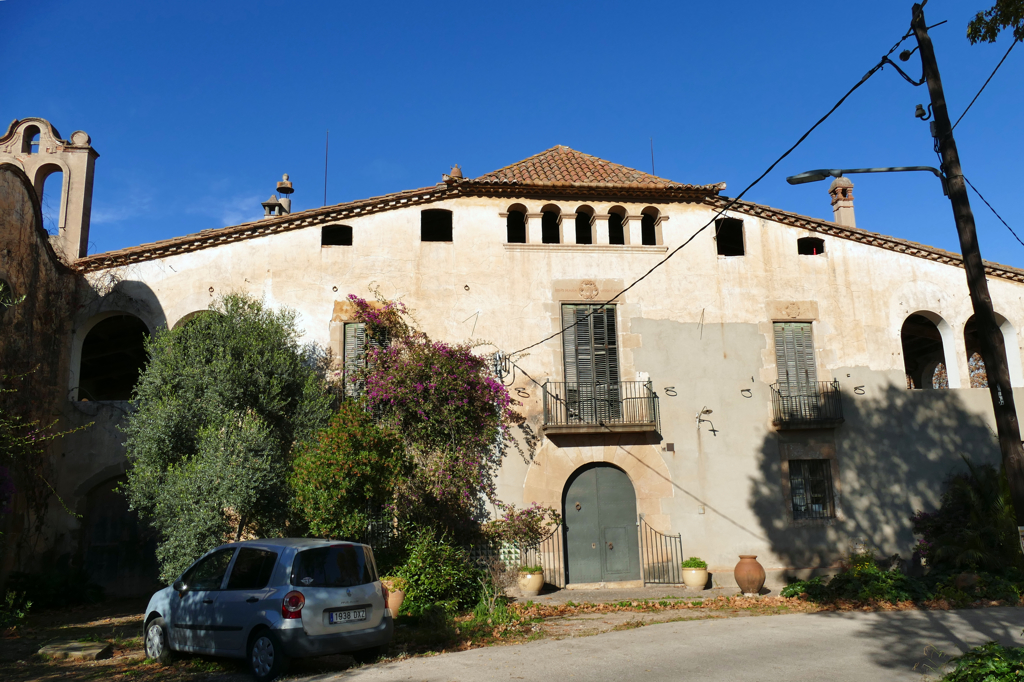
As the Colonia Güell was founded, the house was restored and became the local residence of the Güell family. Arguably, Francesc Berenguer i Mestres was in charge of the alterations. Therefore, you’ll see some characteristic elements of Catalan farmhouses, such as the door, the sunroom gallery, and the sundial on the main façade.
During the civil war, the mansion housed the town hall.
Attached to the farmhouse is the small chapel. This is where the service took place pending the completion of Gaudí’s crypt.
Recinto Industrial, the Industrial Plant
Construction of the factory began immediately in 1890. Only one year later, the first building was ready for housing production. Eventually, further buildings, foreseen for drying, tinting, and other production processes, were completed.
The design of the factory is attributed to Ferran Alsina, a textile technician and inventor, who had already worked for Eusebi Güell in the old Vapor Vell de Sants factory in Barcelona.

Every step of the process of transforming cotton into fabric was implemented in a different building. The building where the spinning of the yarn took place was built according to the English fabric factories known as Manchesteranian. The material was transported between the buildings in cartwheels on rails.
Eventually, labor movements and social revolution reached also the secluded Colonia. Consequently, at the beginning of the civil in 1936, the workers took over. At the end of the war, however, it was returned to the Güell family who sold it to the Bertrand y Serra family in 1945.
Depósito de Agua, the Water Reservoir
Not far from the factory on Can Ros stands the modernist water reservoir built in 1895.

Gaudi’s Crypt
Güell commissioned Gaudí to build a church at the Colonia Güell in 1898. However, the construction began only ten years later after extended planning. Gaudí’s blueprint foresaw a church with two naves on different levels, topped by various towers and a dome.
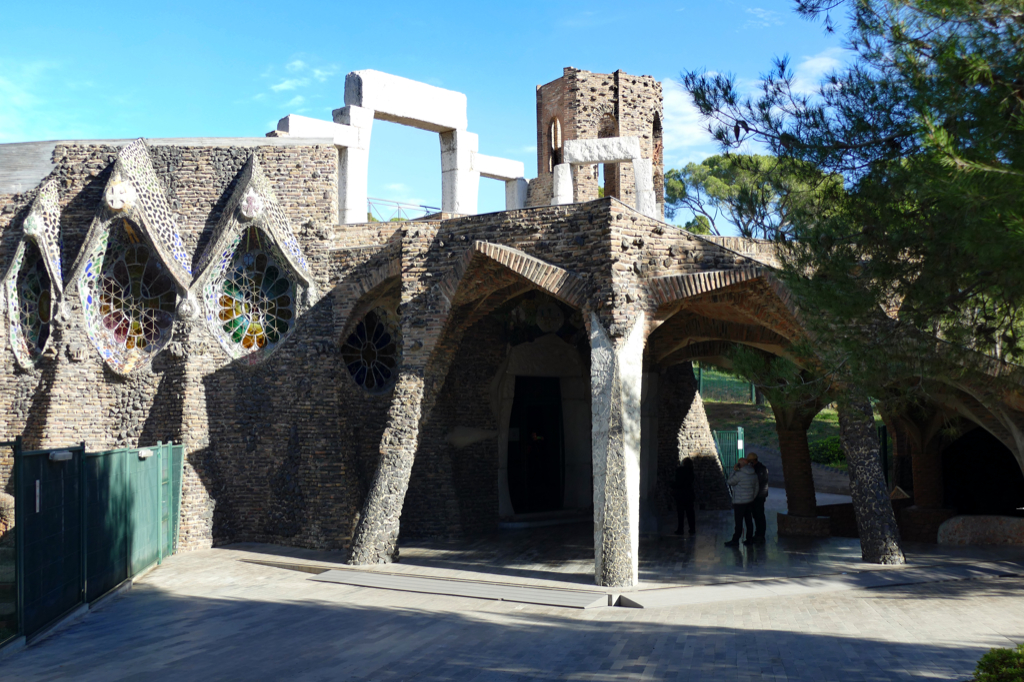
Clearly, the sophisticated project already anticipated elements of the Sagrada Família. And just like Barcelona’s iconic house of worship, it remained unfinished. In 1914, the Güell family renounced financing the building project. Consequently, Gaudí could only complete the lower nave, the so-called crypt, and the portico.
However, already these parts with their typical tilted columns, their sloping walls, and rich symbolic ornamentation unmistakably carry the master’s thumbprint.
Although left unfinished, the Crypt is certainly a paragon of Gaudí’s work. For the first time, he introduced all the architectural features that he later implemented in the Sagrada Família.
You already can see the arches based on the principle of an upside-down chain line that solves the load problem. This method became famous as the Catalan vault. Also, for the first time in the history of architecture, surfaces were designed in the shape of so-called hyperbolic paraboloids, aka saddles.
Sadly, neither the chain model made for the Colònia Güell nor the one used for the Sagrada Família didn’t outlast.
Portico And Portal
As I stated above, many of Gaudí’s legendary features are found in this construction.
He used unplastered brick, natural stone, and ceramics for the walls and façade.
For the porch columns, he used recycled materials just like he did when building the Park Güell in Barcelona.
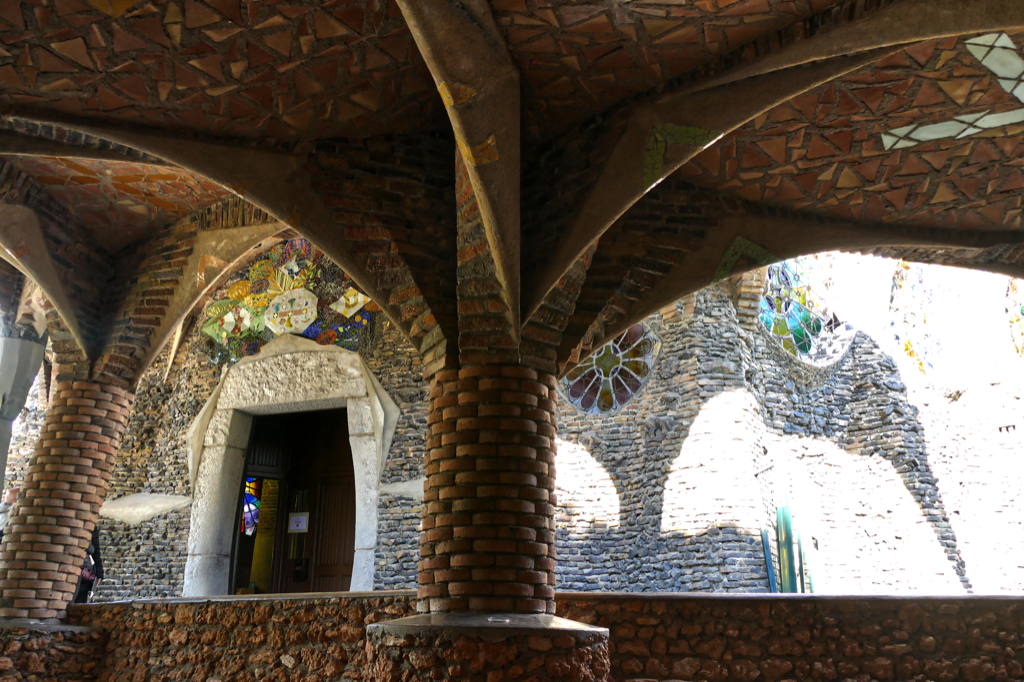
Gaudí used stone blackened from furnace slag as well as black bricks that were burned during the manufacturing process and therefore couldn’t be sold. Also, the bars of the windows are broken loom needles from the factory.
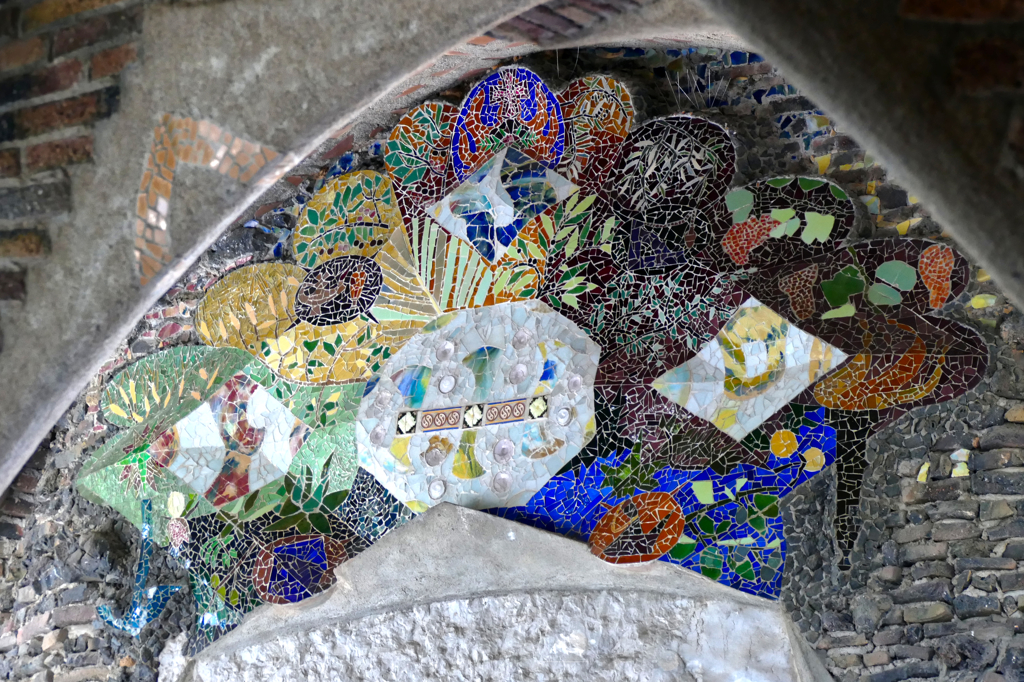
The entrance door is made from masonry stone. Above the door are the four cardinal virtues made from ceramic shards.
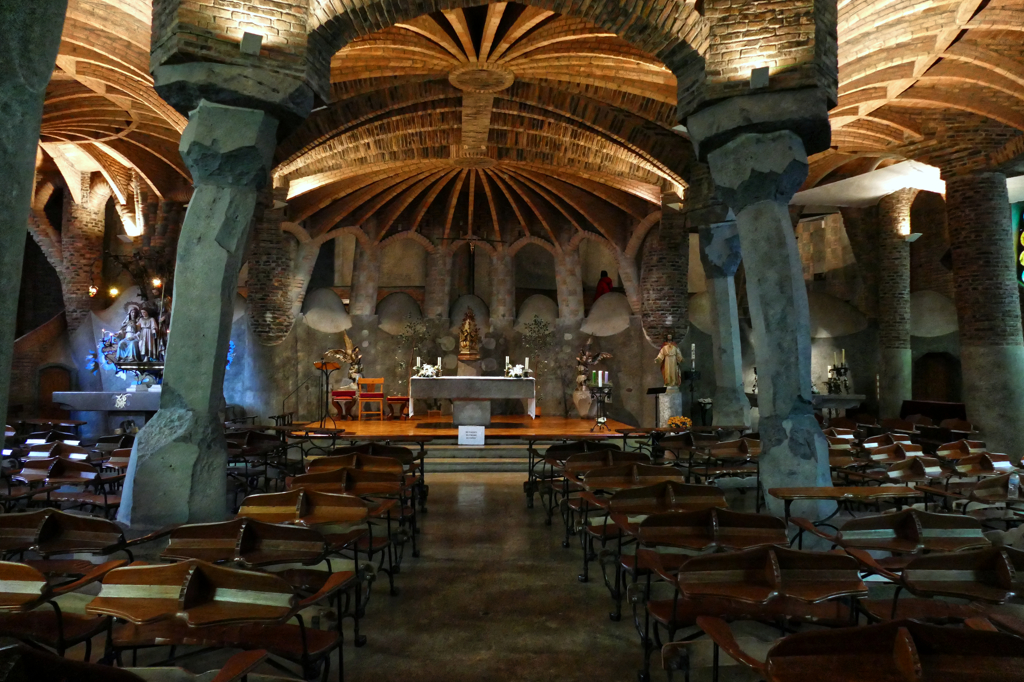
Inside, the lower nave is divided into two levels. The nave itself is on the lower level. The presbytery, the choir, and side rooms are on a higher level behind it.
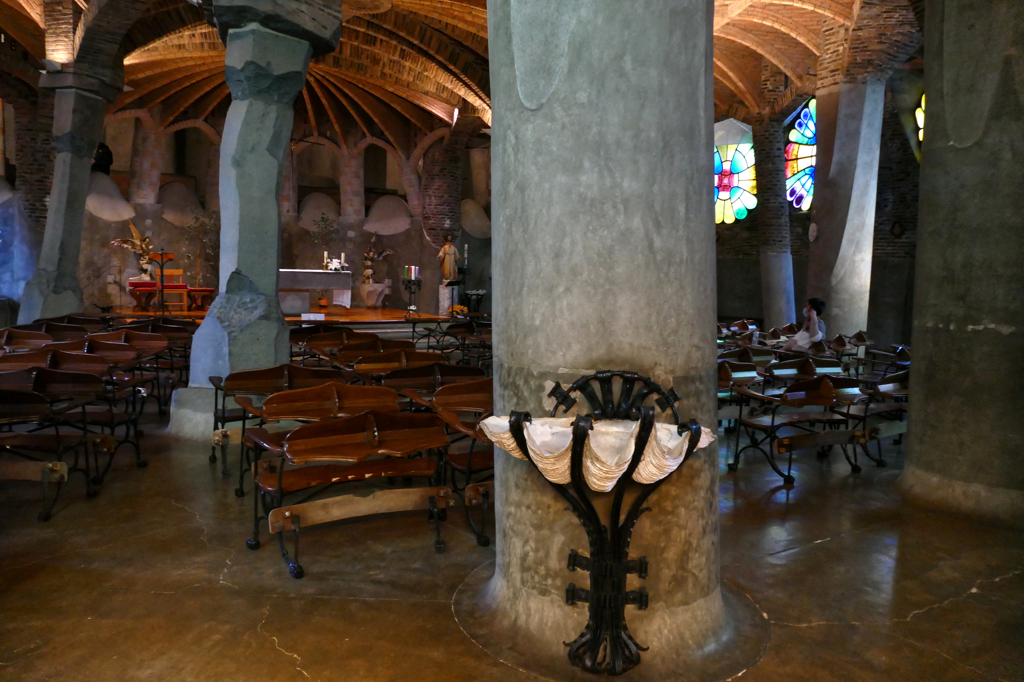
In the large room are four central columns of basalt stone and nine brick pillars arranged in a concentric semicircle. Colored glass in the playful shape of flower petals and butterfly wings embellish the large tear-shaped windows.
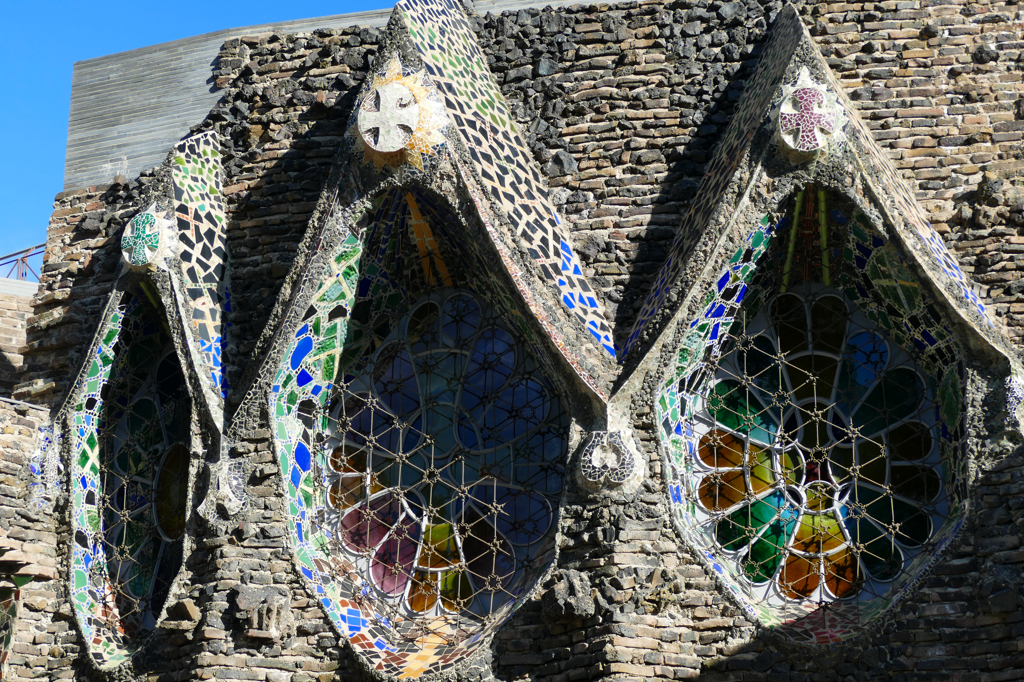
Between 1915 and 1917, another builder closed the unfinished upper nave with brick walls and iron roofs.
In 2005, UNESCO added the crypt and the portico, along with three other works by Gaudí, to the List of World Heritage Sites.
Casa Parroquial, the Parish House
In 1917, hence, the same year Gaudí’s project was definitively suspended, Francesc Berenguer i Bellvehi started to build the parish house.
There are unique historicist details in the door and windows.
The façade is revetted with irregular stone slabs. Brickwork adorns the corners, the plinth, as well as the arches on the ground floor. Brickwork imitating wooden beams covers a wide eave.
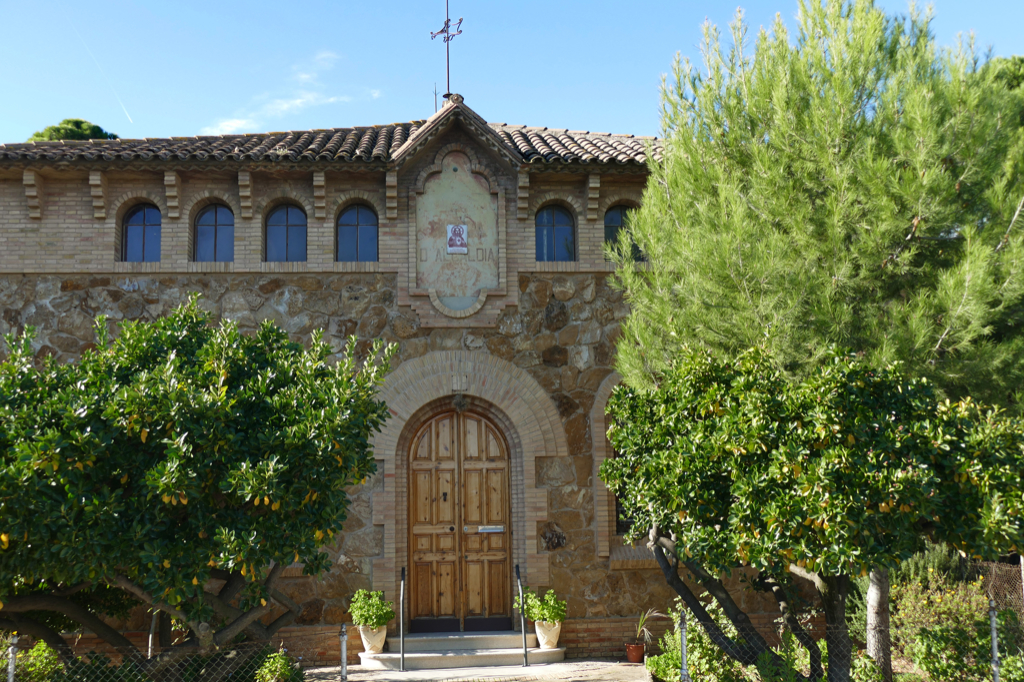
Today, it still houses the parish office, but is also a private residence.
Can Julia de la Muntanya, the Farmhouse
Can Julià de la Muntanya, located on the outskirts of the Colonia Güell, is one of the few farmhouses still existing in the area.
This building from the 17th century has served many different purposes over the centuries. Initially, it housed a congregation of nuns who then moved to the Convento de las Monjas on Carrer Claudi Güell.
Newly arriving workers found temporary shelter before they were given their own house.
Castillo Torre Salvana, the Castle Tower
The Torre Salvana is a Romanesque-style castle that dates back to the 10th century. Its most iconic feature is its high tower.
During the Catalonian Civil War, the castle was partially destroyed in 1224. In the year 1297, King Jaume II bought the castle for an equivalent of 130,000 salaries. In 1390, his heirs sold it to the city of Barcelona.
Due to the war between Jaime I and Joan II, the castle was abandoned in 1715 and deteriorated ever since. Today, it is in ruins.

As various legends about the Torre de Salvana castle go around, it is also called the castle of hell. People get there to experience all sorts of supernatural phenomena. For instance, some people claim they have felt something grab them. A stone was flung at people sitting around a spirit board in a closed room. Others assert having seen black, dense, and viscous smoke entering through a window and lingering over their heads. Some have spotted a pale girl with long black hair in a white nightgown with a bullet hole in her forehead.
So, you’re curious now? Then go looking for the stone, the smoke, and the poor girl on a short walk from the Colonia.
How to Get to Santa Coloma de Cervelló
Getting to Santa Coloma de Cervelló is fast and easy. You can take lines #3, #4, #8, or #9 from Plaça d’Espanya to the Colonia Güell stop. Actually, it’s not a problem if the train goes only to the Molí Nou – Ciutat Cooperativa stop. From there, you can walk to Santa Coloma de Cervelló in less than 15 minutes.
If you are on a visit to Barcelona and you have a Barcelona Card*, these rides are included.
On the weekend, there is a special train decorated with Guadí’s Crypt. It is line #4 that leaves Plaça d’Espanya at 10.58 a. m. On the way back to Barcelona, take line #3 at the Colonia Güell stop at 2.11 p. m.
How to Visit the Colonia Güell
Santa Coloma de Cervelló is a village, so you can go there any time you please, obviously, and with this post, you have a perfect overview of which buildings to see.
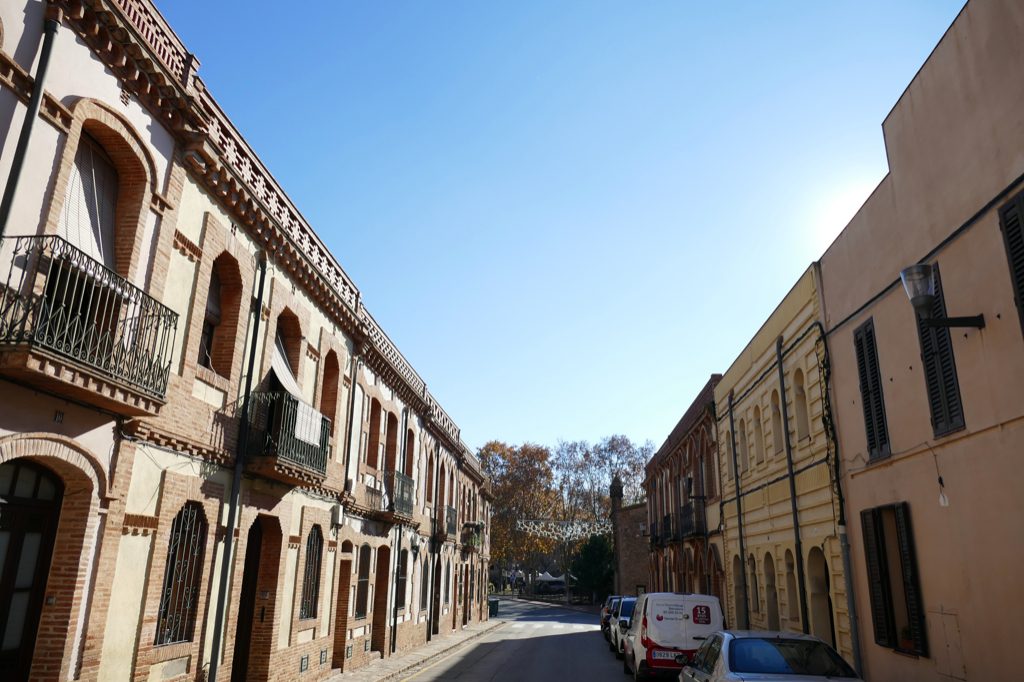
However, if you want more detailed information, you can visit the town on a self-guided tour with an audio guide that comes in 9 languages. You can pick it up at the information center every day between 10 a. m. and 3 p. m. This tour costs 9.50 €uros and you’ll get a 20 percent discount with a Barcelona Card*. There are also different kinds of guided tours, hence, you might want to check out their website to plan your visit.
Where to Eat
As I mentioned above, the restaurant Ateneu Unió in the eponymous building on Plaça Joan Güell 5 is still operating and remains one of the town’s most popular eateries and hangouts. Therefore, it tends to be packed, especially on weekends. But as you walk eastwards on Carrer Barrau, you’ll get to a big park. On the left side of the street are two restaurants serving Spanish cuisine. The Bar Sport even has outdoor seating from where you can see the park as well as the Ca L’Ordal while enjoying your tapas.
Colonia Güell is the perfect half-day trip from Barcelona. It was definitely one of the highlights of my road trip through Spain. To read about the others, go to the main post and take your pick! There, you’ll also find further valuable general information that will make your own trip much smoother and more enjoyable.
Map
This map should help you to find the most iconic structures that have formed the Colonia Güell:
Pinnable Pictures
If you choose to pin this post for later, please use one of these pictures:

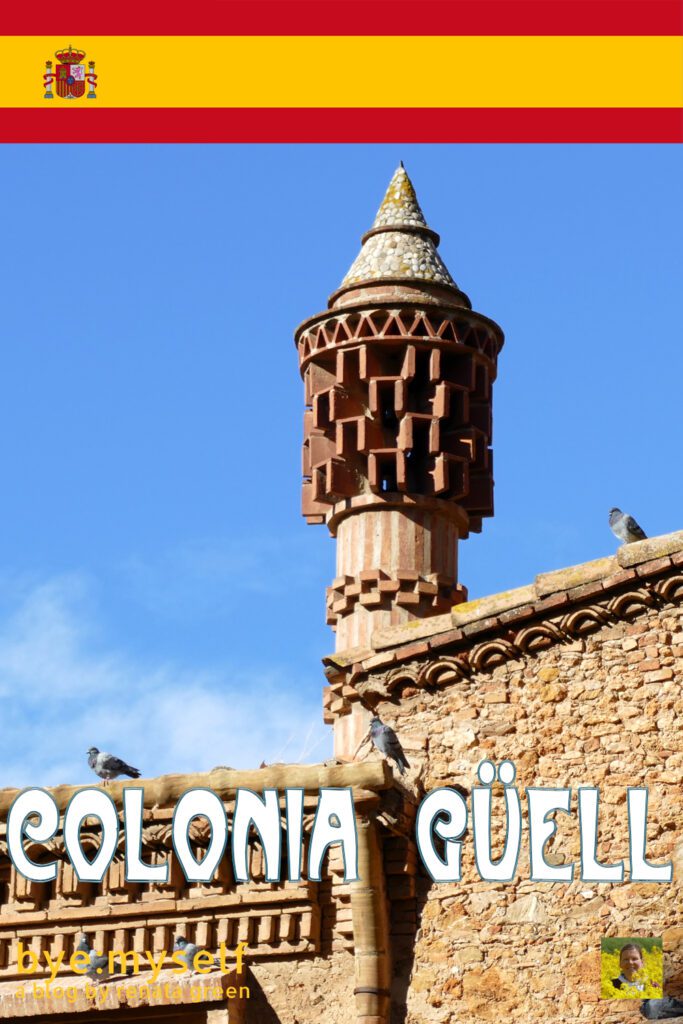
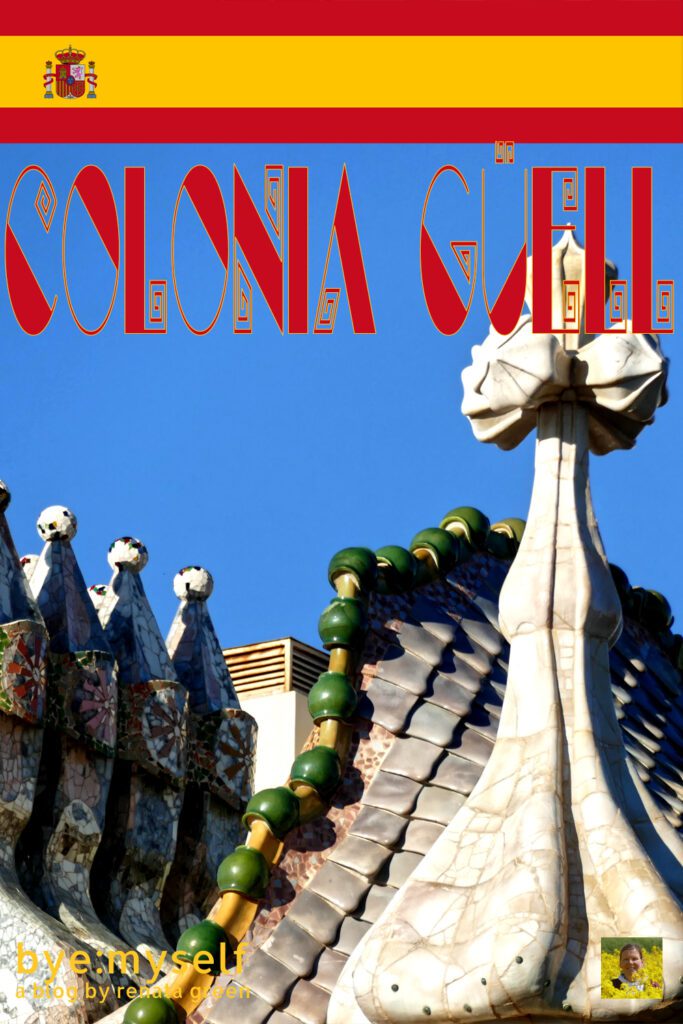
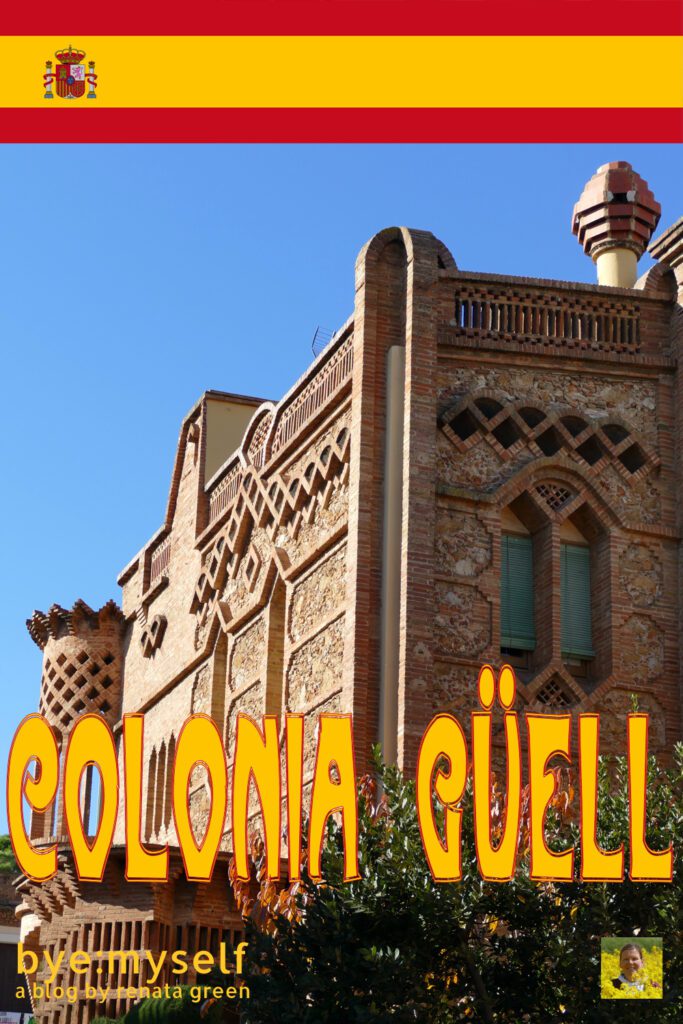

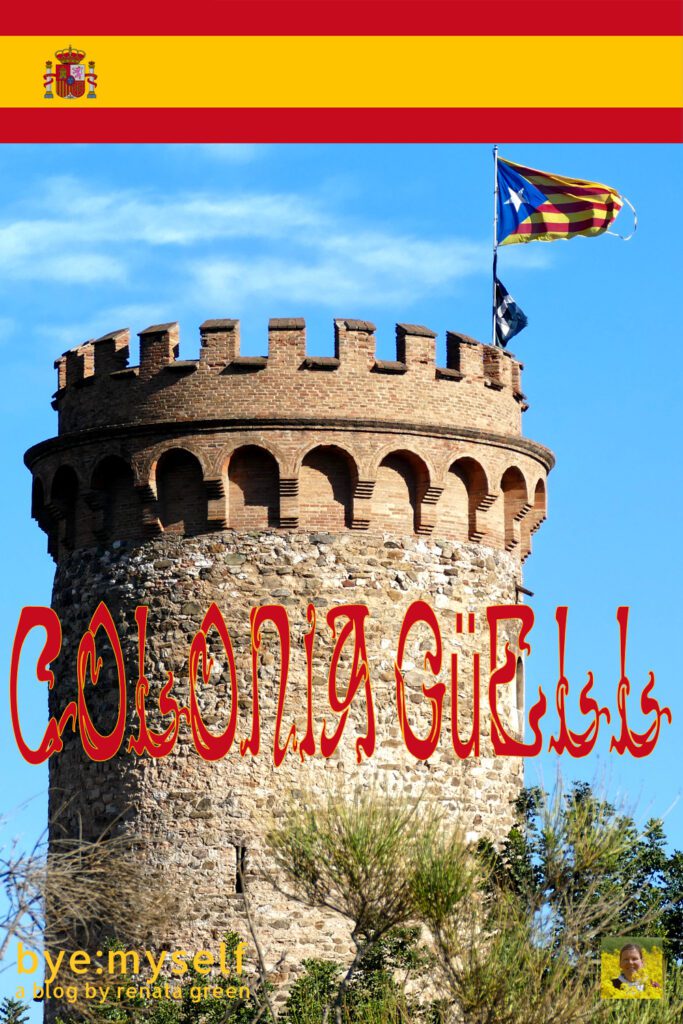
Did You Enjoy This Post? Then You Might Like Also These:
How to See the Highlights of LANZAROTE in Two Days
Hiking the Circular Trail Around PUIGPUNYENT
Day Trip to AGÜIMES and SANTA BRIGIDA – going to the heights of beauty
Guide to PUERTO DE LA CRUZ – a Town Full of Contrasts
One Day in SANTA CRUZ de TENERIFE
Best STREET ART in PALMA de MALLORCA
Guide to SEVILLE – Three Days Right Where Andalusia’s Heart is Beating to the Rhythm of Flamenco
PALMA de MALLORCA – what to see in two days
* This is an affiliate link. Hence, If you book through this page, not only do you get the best deal. I also get a small commission that helps me run this blog. Thank you so much for supporting me!


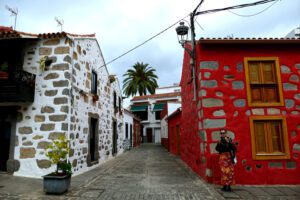

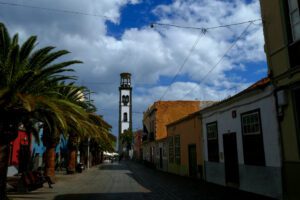
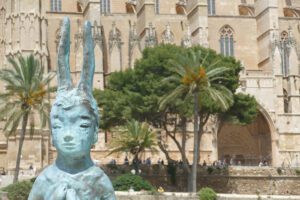

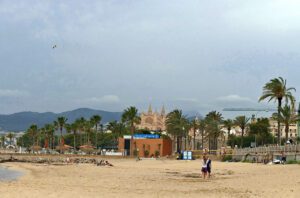
We love all the amazing Gaudi treasures around Barcelona. But we have not yet visited Colonia Güell. So it was great to wander through this amazing spot through your blog post. Even if these buildings are not quite as fanciful of some others, there is architectural detail and art everywhere. But Antoni Gaudi’s Crypt is as colourful as I would expect it to look!
Since it’s not within Barcelona’s city limits, it remains under many visitors’ radar. Probably a good thing for the inhabitants 😉
Architectural design is one of the many things that amazes me when I travel and this Colonia Güell has it! Hope to visit one day.
It would just blow you away 🙂
Such a beautiful place that’s it’s so close to Barcelona. I would love to visit Barcelona again soon and I will put this place on my list as a day trip 🙂
I never heard of Eusebi Güell, nor Colonia Guell, but it seems like a really nice place full of culture and history. I would love the view the history there.
Eusebi Güell is mostly known for the Parque Güell in Barcelona. The Colonia, however, is a rather hidden gem 🙂
You had me hooked since the first photo. I have never heard of this place but OMG I want my house decorated and designed just like this with the different colored tiles around the windows. It looks so magical!
It’s a super-interesting place that many visitors to Barcelona have never heard of before 🙂
What an incredible place to visit! La Sagrada Familia is so well known but I never heard of the Colonia Guell. The architecture is striking, and very much a characteristic of Guell. Would love to see this in person the next time we visit Barcelona.
Yes, I’m afraid that the centrally located landmarks of Barcelona somehow overshadow the rest. There is simply far too much to see 😉
What a fascinating community. Guell was certainly a visionary and art patron. It would be a great day trip from Barcelona.
I have to admit I missed that place during my visit to Barcelona (or might have completely forgotten about it too, maybe). The place looks amazing, and very beautiful, thank you for the tour.
I think it’s under many visitors’ radar – hence, this post 😉
That farmhouse is so cool and I love the history – the boy who betrayed them. So much cool history here!
Yes, the farmhouse was my favorite building, too 🙂
Sagrada Família in Barcelona looks absolutely stunning and unique. What an amazing experience!
That is a unique place of worship! I love the stunning mosaic! Barcelona is on my bucket list so I will add this Colonia Guell to my Barcelona must-sees!
Yes, Gaudi had an extremely good eye for mosaics 🙂
What stunning buildings. It’s a shame the family weren’t willing to fund the project being finished, but I’m glad they have at least managed to preserve much of it. Great post
At least he was able to finish the lower part 😉
The architecture in your photos is captivating! Colonia Guell is certainly worth visiting given the unique buildings and rich history.
Yap, it was even better than expected 😉
One of my favourite parts about visiting Barcelona was seeing all of Gaudi’s works throughout the city. I had no idea there was also a Colonia Guell! I can’t wait to get back to Barca and I will definitely be sure to add this to the itinerary. The Crypt and Castle tower looks especially amazing ?
Yes, if you have the chance, you should definitely go – it’s really very interesting 🙂